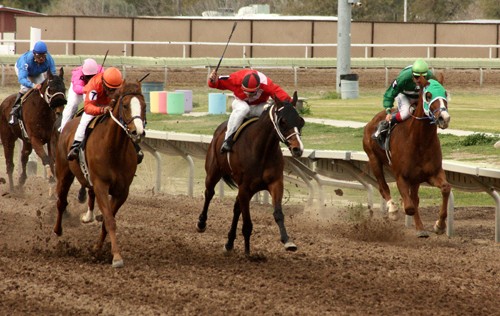Every January and February, Rillito Park hosts three weekends of horse racing. As a newcomer to the world of horse racing, I had no idea what to expect when I walked into the park Sunday. Entering the gates half an hour before start time, I found myself engulfed in the Tucson of old. Surrounded by cowboys, purebred horses and lots of dirt, I had no idea how exciting the experience would end up being.
I’ve never participated in much of anything outside my comfort zone without laughing, and I’ve certainly never been a part of any event that has meant so much to people for such a long time.
I was reminded of this when I saw a man with a leather jacket that proudly stated “”Rillito Park Races — 1984.”” It wasn’t too hard to imagine that many of these cowboy hats and rancher boots had been bought before I was even alive. The history of this place was evident by the aging white sign that adorned the front of the complex, the thick rust coating every bench in the grandstands and the dilapidated scoreboard. The old-school odds board in particular surprised me with its charm. It wasn’t even digital! The betting register had remnants of paint worn off long ago. It was as if the venue couldn’t do enough to convince me that this was an authentic experience.
People swarmed around the thoroughbreds as I walked through the crowds. I bought a hot dog and a Pepsi at the concession stand and promptly placed a bet on horse number six with no knowledge of how odds work. I felt accomplished as I walked up to the grandstand. The event was slated to start soon and I waited with anticipation as the horses were walked out for the first race. The crowd chattered until a piercing trumpet cut through the noise with the sounds of our national anthem.
I felt a bit jostled when the whole park got serenely quiet during the song I’ve heard so many times during the Winter Olympics. Since I live in student apartments, silence is something I rarely hear. I paused to look around. It was here where I first felt the gravity of the whole event. People from different backgrounds gathered here every weekend, twice a year, to enjoy the one thing they all had in common. From retired couples to Mexican-American cowboys to university students, everyone was represented in that moment.
Before the races started, the classic trumpet tune pierced the silence to indicate everyone should pay attention. The purebreds shot off for a fast lap around the track.””Damn!”” I yelped when they took off with astonishing speed. I lost $5 on horse number six in just 45 seconds, but I couldn’t have been less disappointed. With my uneducated bet, I hadn’t expected faring any better and I probably got what I deserved. Losing money has never been so fun. The $5 was worth watching 700-pound horses have the jitters before the gunshot and seeing their rippling muscles fire as they ran.
When a group of smaller horses came to the back to prepare, I asked an elderly woman if mules were racing too. She paused as the gray hair on her temples throbbed slightly. I could almost hear her wondering whether I was serious. She peered at me strangely through her razor-thin glasses and said quietly, “”Those are quarter-horses.”” I blushed profusely and thanked her.
After another race or two I quietly gathered my things and decided to go. I’m not much of a people person and the festive atmosphere had worn me down. As I walked out, I stopped to take a look at the jockey area. The jockeys wore bright outfits in bold hues of red, blue and green. It was evident these were just normal people who loved what they did. In their normal lives, they likely worked full-time jobs and had families. On weekends, they were here — celebrities in their chosen world.
If the races at Rillito Park taught me anything, it’s that diversity can be found in even the most unlikely places. Even in a place like Tucson, where college students generally assume that all there is to do is party, this stood out as one of the gems of culture. Many years after its inception, the races remain living proof that there is fun to be had in Tucson if you are willing to look for it.
After being told by a tall and apathetic teenaged concession worker that the city is currently in talks to raze the track to make room for more soccer fields, I couldn’t help but feel depressed at the thought of this unique piece of Tucson being destroyed. Looking around at everyone who had invested in this opportunity by buying real snakeskin boots and felt-textured hats, I thought it would be a real shame if this ever came to pass. Rillito Park represents a small but important part of southern Arizona’s landscape. After my experience there, I can’t imagine it disappearing. While it may have been just a pleasant afternoon for me, for many people the park represents half a lifetime of personal investment and memories.
Here’s to not letting it all go to waste.









